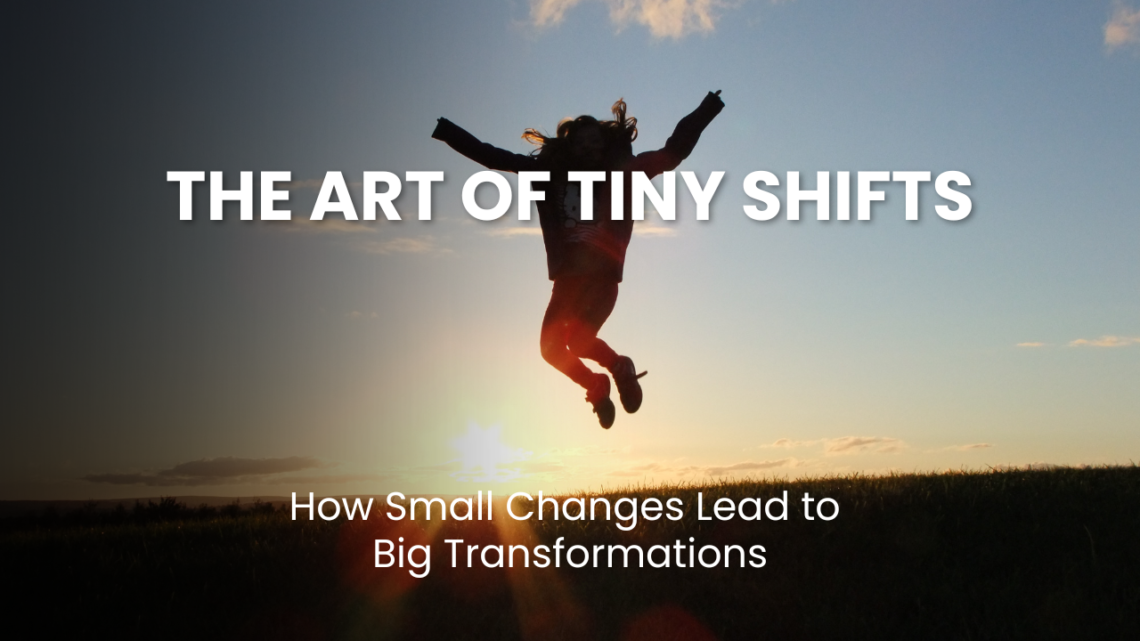We often dream of dramatic transformations – losing weight, mastering a new skill, achieving a long-held goal. But the sheer magnitude of these aspirations can feel overwhelming, leading to procrastination and ultimately, failure. What if the secret to achieving these monumental changes wasn’t about giant leaps, but rather, the art of tiny shifts? What if the key to unlocking your full potential lies in the power of incremental improvements? This blog post delves into the profound impact of small changes, exploring how these seemingly insignificant adjustments can lead to remarkable transformations in your habits, mindset, and routines, ultimately shaping a better you.
The Psychology of Small Wins: Why Tiny Shifts Work

Our brains are wired for survival. They prioritize stability and predictability, often perceiving change as a threat. This is why sudden, drastic changes, even positive ones, can trigger a resistance response. The amygdala, the brain’s emotional center, can become activated, leading to feelings of anxiety, stress, and overwhelm. This resistance makes it harder to stick to new routines and ultimately hinders our progress. It’s like trying to force a square peg into a round hole – it creates friction and discomfort.
Tiny Shifts: The Path of Least Resistance:
Tiny shifts, by their very nature, are non-threatening. They are so small and manageable that they don’t trigger the same resistance response. Instead of feeling like a monumental challenge, they feel achievable, even easy. This “low-hanging fruit” approach allows us to bypass the amygdala’s alarm bells and gently nudge ourselves in the desired direction. It’s like opening a door a crack instead of trying to break it down – much less resistance and far more effective.
The Dopamine Boost: The Reward of Small Wins:
When we accomplish even a small task, our brains release dopamine, a neurotransmitter associated with pleasure, motivation, and reward. This “dopamine hit” reinforces the behavior, making us more likely to repeat it. This is the essence of the “small win” effect. Each tiny accomplishment, however insignificant it may seem, provides a small dose of dopamine, fueling our motivation and encouraging us to keep going. It’s like feeding a fire with kindling – small flames build into a larger, more powerful blaze.
Building Momentum: From Small Wins to Big Transformations:
The beauty of the small win effect is that it creates a positive feedback loop. Each small success generates a feeling of accomplishment, which in turn motivates us to take the next small step. This momentum builds over time, leading to significant progress. It’s like rolling a snowball downhill – it starts small but gathers more snow and momentum as it goes, eventually becoming a large and powerful force.
The Power of Positive Reinforcement:
Tiny shifts are a form of positive reinforcement. By focusing on small, achievable steps, we are constantly rewarding ourselves with small wins, which reinforces the desired behavior. This is much more effective than relying on willpower or self-discipline, which can be easily depleted. Positive reinforcement creates a sustainable cycle of motivation and progress. It’s like training a dog with treats – rewarding desired behavior is much more effective than punishment.
Overcoming Procrastination:
Procrastination often stems from feeling overwhelmed by the size of a task. Tiny shifts can be a powerful antidote to procrastination. By breaking down large tasks into smaller, more manageable steps, we can make them feel less daunting and more approachable. This reduces the feeling of overwhelm and makes it easier to get started. Once we’ve taken that first small step, the momentum builds, and we’re more likely to keep going. It’s like eating an elephant one bite at a time – a seemingly impossible task becomes manageable when broken down into smaller pieces.
The Importance of Celebrating Small Wins:
It’s crucial to acknowledge and celebrate our small wins, no matter how insignificant they may seem. This reinforces the positive feedback loop and keeps us motivated. Celebrating small wins doesn’t have to be extravagant. It can be as simple as acknowledging our progress in a journal, sharing our accomplishments with a friend, or simply taking a moment to appreciate how far we’ve come. It’s like watering a plant – even small amounts of water contribute to its growth and flourishing.
By understanding the psychology of small wins, we can harness the power of tiny shifts to achieve our goals and create lasting change. It’s not about striving for perfection or making dramatic overhauls. It’s about focusing on small, consistent improvements that, over time, will lead to remarkable transformations.
The Core Principle: Small, Consistent Actions + Time = Significant Results

At its heart, the compound effect is a simple yet powerful principle: small, consistent actions, repeated over time, will lead to significant, often surprising, results. It’s not about making huge leaps or achieving overnight success. It’s about the accumulation of small, seemingly insignificant gains that, over time, multiply and compound, creating a substantial difference. Think of it as planting a tiny seed. On its own, the seed looks insignificant. But with consistent watering, sunlight, and care, it grows into a mighty tree.
The Analogy of Compound Interest:
The most common analogy for the compound effect is compound interest in finance. Imagine investing a small amount of money and earning interest on it. In the first year, the interest earned might be small. But in the second year, you earn interest not only on your initial investment but also on the interest earned in the first year. This process continues, with each year’s interest building upon the previous year’s, leading to exponential growth over time. The compound effect works in a similar way with our habits, routines, and mindset.
Beyond Financial Growth: Applying the Compound Effect to Life:
The compound effect isn’t limited to finances. It applies to virtually every area of life, including:
- Health and Fitness: Consistent exercise, even if it’s just 15 minutes a day, compounds over time, leading to improved fitness, weight loss, and better overall health. Choosing to eat a healthy snack instead of junk food, consistently, has a compounding effect on your well-being.
- Learning and Skill Development: Dedicate just a few minutes each day to learning a new language, practicing a musical instrument, or reading about a topic of interest. These small, consistent efforts will compound over time, leading to mastery and expertise.
- Relationships: Small acts of kindness, appreciation, and communication, consistently practiced, compound over time, strengthening bonds and creating deeper, more meaningful relationships.
- Personal Development: Reading a few pages of a self-improvement book each day, reflecting on your experiences, or practicing mindfulness can have a profound compound effect on your personal growth and self-awareness.
- Career: Consistently putting in extra effort, learning new skills, and building relationships can compound over time, leading to career advancement and success.
The Importance of Consistency:
The key to unlocking the compound effect is consistency. It’s not about making huge bursts of effort occasionally. It’s about showing up consistently, day after day, even when you don’t feel like it. Small, consistent actions are far more effective than sporadic bursts of energy. It’s like the tortoise and the hare – the tortoise, with its slow and steady pace, eventually wins the race.
The Power of Small Changes:
The beauty of the compound effect is that it doesn’t require massive changes. In fact, it’s the small, seemingly insignificant changes that have the biggest impact over time. These small changes are easy to implement and don’t feel overwhelming, making them more sustainable in the long run.
The Long-Term Perspective:
The compound effect is a long-term game. It requires patience and a willingness to trust the process. You may not see significant results immediately. In fact, in the early stages, the progress might seem negligible. But over time, as the small gains compound, the results will become more and more apparent.
The Snowball Effect:
The compound effect can be visualized as a snowball rolling downhill. It starts small but gathers more snow and momentum as it goes, eventually becoming a large and powerful force. Similarly, small, consistent actions, over time, gather momentum and lead to increasingly significant results.
Overcoming the “Instant Gratification” Mindset:
In a world of instant gratification, the compound effect can be challenging to embrace. We are often conditioned to expect immediate results. However, the compound effect teaches us the importance of patience and delayed gratification. It reminds us that true and lasting success is built on small, consistent actions, repeated over time.
Tracking and Measuring Progress:
Tracking your progress can be a powerful motivator when harnessing the compound effect. Seeing how your small, consistent actions are adding up over time can reinforce your efforts and keep you motivated. Use a journal, app, or spreadsheet to track your progress and celebrate your milestones, no matter how small they may seem.
Identifying Your Tiny Shifts: Where to Start

Let’s delve into the process of identifying your tiny shifts, the crucial first step in harnessing the power of incremental improvement. This section will guide you through a practical approach to pinpointing the specific areas where small changes can make a big difference.
1. Self-Reflection: Understanding Your Goals and Aspirations:
The journey to identifying your tiny shifts begins with honest self-reflection. Ask yourself:
- What are my long-term goals? Where do I see myself in a year, five years, or even ten years? Be specific. Instead of “being successful,” define what success means to you. Is it related to your career, relationships, health, finances, or personal growth?
- What are my current habits and routines? Take an inventory of your daily life. What do you do regularly? What habits are serving you, and which ones are holding you back? Be honest with yourself. This isn’t about self-judgment, but about gaining awareness.
- What areas of my life do I want to improve? Which areas are causing you stress, dissatisfaction, or preventing you from reaching your goals? Is it your health, productivity, relationships, finances, or something else?
- What are my values? What is truly important to you? Aligning your tiny shifts with your core values will make them more meaningful and sustainable.
2. Breaking Down Big Goals into Smaller, Manageable Steps:
Once you’ve identified your goals and the areas you want to improve, the next step is to break down those big goals into smaller, more manageable steps. This is where the concept of tiny shifts comes into play. Instead of focusing on the overwhelming end goal, concentrate on the small, achievable actions you can take today, tomorrow, and the day after.
- Example: Let’s say your goal is to write a book. Instead of feeling overwhelmed by the thought of writing hundreds of pages, break it down into smaller steps. A tiny shift could be writing just 250 words a day. Consistent effort at this level will eventually lead to a completed manuscript.
3. Focusing on One or Two Areas at a Time:
It’s tempting to try and change everything at once, but this approach often leads to burnout and failure. Instead, focus on one or two key areas you want to improve. Once you’ve established some positive momentum in those areas, you can then move on to other areas.
- Example: If you want to improve your health and your productivity, you might start by focusing on two tiny shifts: drinking more water and spending 15 minutes each morning planning your day. Once these habits become ingrained, you can then introduce other changes, such as exercising regularly or learning a new skill.
4. Identifying Keystone Habits:
Keystone habits are small changes that have a ripple effect, influencing other areas of your life. Identifying and focusing on these keystone habits can be particularly effective.
- Example: Improving your sleep can be a keystone habit. When you sleep better, you have more energy, which can lead to increased productivity at work, improved mood, and better relationships.
5. The “One Percent Improvement” Philosophy:
Embrace the philosophy of “one percent improvement” each day. Even if you only make a tiny improvement each day, those small gains will compound over time, leading to significant results.
- Example: If you’re learning a new language, instead of trying to memorize hundreds of words at once, focus on learning just five new words each day. Over a year, that adds up to over 1,800 words!
6. Considering Your Environment and Resources:
Think about your environment and the resources available to you. How can you set yourself up for success? Are there any obstacles you need to overcome?
- Example: If you want to eat healthier, make sure you have healthy food readily available in your fridge and pantry. If you want to exercise more, find a gym or workout routine that you enjoy and that fits into your schedule.
7. Asking for Help and Support:
Don’t be afraid to ask for help and support from friends, family, or mentors. Sharing your goals with others can help you stay accountable and motivated.
8. Experimenting and Adjusting:
Finding the right tiny shifts is often a process of experimentation. What works for one person may not work for another. Be willing to try different approaches and adjust your plan as needed.
9. Using the SMART Criteria:
When defining your tiny shifts, consider using the SMART criteria:
- Specific: Clearly define what you want to achieve.
- Measurable: Make sure your progress is trackable.
- Achievable: Choose shifts that are realistic and attainable.
- Relevant: Ensure your shifts align with your goals and values.
- Time-bound: Set a timeframe for achieving your shifts.
By following these steps, you can effectively identify your tiny shifts and begin your journey towards significant personal transformation. Remember, it’s not about making massive changes overnight. It’s about focusing on small, consistent improvements that, over time, will lead you to your desired destination.
Implementing Your Tiny Shifts: Strategies for Success

Let’s explore practical strategies for successfully implementing your chosen tiny shifts and making them stick. Turning good intentions into consistent actions requires a structured approach.
1. Start Small, Think Big:
The core principle of tiny shifts is to begin with incredibly small, almost ridiculously easy actions. This removes the feeling of overwhelm and makes it much easier to get started. Don’t worry about the big picture just yet; focus on the tiny step in front of you.
- Example: Instead of aiming to meditate for 30 minutes a day, start with just 2 minutes. Once that becomes a consistent habit, gradually increase the duration.
2. Be Consistent, Not Perfect:
Consistency is paramount. It’s better to do a tiny shift consistently than to do a larger action sporadically. Don’t strive for perfection; strive for consistency. There will be days when you slip up, and that’s okay. Just get back on track as soon as possible.
- Example: If you miss a day of your 2-minute meditation, don’t beat yourself up about it. Just make sure you do it the next day.
3. Anchor Your Tiny Shifts to Existing Habits:
“Habit stacking” is a powerful technique. Link your new tiny shift to an existing habit. This creates a trigger and makes it easier to remember and perform the new action.
- Example: If you want to drink more water, place a glass of water next to your toothbrush. Every time you brush your teeth, you’ll be reminded to drink the water.
4. Create a Supportive Environment:
Your environment plays a significant role in shaping your habits. Modify your surroundings to make it easier to perform your tiny shifts.
- Example: If you want to eat healthier, keep healthy snacks readily available and remove unhealthy temptations from your pantry. If you want to read more, keep a book on your nightstand.
5. Track Your Progress:
Tracking your progress can be a powerful motivator. Seeing how your small, consistent actions are adding up can reinforce your efforts and keep you on track.
- Example: Use a habit tracking app, a journal, or a spreadsheet to record your daily accomplishments. Seeing a chain of completed habits can be very motivating.
6. Make it Enjoyable:
The more enjoyable your tiny shifts are, the more likely you are to stick with them. Find ways to make your new habits fun and engaging.
- Example: If you want to exercise more, find a type of exercise that you enjoy, such as dancing, hiking, or swimming.
7. Reward Yourself (Sparingly):
While the intrinsic reward of the small win is powerful, occasional external rewards can also be helpful, especially in the early stages. However, be careful not to rely too heavily on external rewards, as you want the habit to become intrinsically motivating.
- Example: After a week of consistently meditating for 5 minutes a day, treat yourself to a relaxing bath or a cup of your favorite tea.
8. Be Patient and Persistent:
Building new habits takes time and effort. Don’t get discouraged if you don’t see results immediately. Trust the process and keep making those tiny shifts. The compound effect will work its magic over time.
9. Embrace Imperfection:
There will be days when you slip up and don’t stick to your plan. Don’t beat yourself up about it. Just acknowledge the slip-up and get back on track as soon as possible. Everyone makes mistakes; the key is to learn from them and keep moving forward.
10. Review and Adjust:
Regularly review your progress and make adjustments as needed. What worked in the beginning may not be as effective later on. Be flexible and willing to adapt your plan as you grow and evolve.
11. Find an Accountability Partner:
Sharing your goals with someone else can help you stay accountable and motivated. Find a friend, family member, or mentor who can support you on your journey.
12. Visualize Success:
Imagine yourself successfully performing your tiny shifts. Visualization can be a powerful tool for reinforcing positive behavior and building confidence.
13. Celebrate Your Wins (Even the Small Ones):
Acknowledge and celebrate your progress, no matter how small. This reinforces the positive feedback loop and keeps you motivated. Celebrating small wins doesn’t have to be extravagant. It can be as simple as taking a moment to appreciate how far you’ve come.
The Ripple Effect: How Tiny Shifts Impact Other Areas of Your Life

Let’s explore the fascinating ripple effect of tiny shifts, where seemingly small changes in one area of your life can create positive waves that influence and improve other, often unrelated, aspects. This interconnectedness is a key element in understanding the true power of incremental improvement.
The Interconnectedness of Life:
Our lives are not compartmentalized. Our physical health, mental well-being, relationships, career, and personal growth are all interconnected. A change in one area can have a cascading effect, influencing other areas in surprising ways. This is the essence of the ripple effect. Like a pebble dropped into a still pond, the initial disturbance creates waves that spread outward, impacting the entire surface.
How Tiny Shifts Create Ripples:
When you make a tiny shift in one area, it often creates a positive feedback loop. This positive energy can then spill over into other areas of your life.
- Example 1: Improved Sleep: Let’s say you make a tiny shift to improve your sleep, such as going to bed 30 minutes earlier each night. Better sleep can lead to increased energy levels, improved focus and concentration, a more positive mood, and better stress management. These improvements can then positively impact your work performance, your relationships, and your overall sense of well-being.
- Example 2: Regular Exercise: Starting a tiny shift of 15 minutes of brisk walking each day can have a ripple effect. Improved physical health can lead to increased energy, better sleep, reduced stress, and improved mood. These benefits can then translate into greater productivity at work, more fulfilling relationships, and a greater sense of self-confidence.
- Example 3: Mindful Meditation: Even a few minutes of daily meditation can create ripples of positive change. Mindfulness can improve your focus, reduce anxiety, enhance emotional regulation, and increase self-awareness. These improvements can then positively impact your decision-making, your communication skills, and your ability to handle challenging situations.
The Domino Effect:
The ripple effect can also be described as a domino effect. One small change can knock over the next domino, creating a chain reaction of positive changes.
- Example: You start by making a tiny shift to drink more water. This leads to improved hydration, which then leads to increased energy levels. Increased energy makes it easier to exercise. Regular exercise leads to better sleep. Better sleep improves your mood. Improved mood enhances your relationships. And so on.
Unforeseen Benefits:
One of the beautiful things about the ripple effect is that it can lead to unforeseen benefits. You might start a tiny shift with one goal in mind, but you end up experiencing positive changes in areas you didn’t even anticipate.
- Example: You start meditating to reduce stress, but you also discover that it improves your creativity and problem-solving skills.
Amplifying the Ripples:
While the ripple effect often happens naturally, you can also take steps to amplify it. Once you’ve experienced the positive effects of a tiny shift, look for ways to extend those benefits to other areas of your life.
- Example: If you’ve noticed that improved sleep has increased your productivity at work, consider how you can apply that increased focus and energy to other tasks or projects.
The Importance of Holistic Thinking:
The ripple effect highlights the importance of holistic thinking. Instead of viewing your life as a collection of separate parts, recognize the interconnectedness of all aspects of your being. A change in one area can have far-reaching consequences, influencing your overall well-being in profound ways.
Beyond the Individual:
The ripple effect isn’t limited to individual lives. It can also apply to communities and organizations. A small change in one team or department can have a positive impact on the entire organization. A small act of kindness can create ripples of positivity that spread throughout a community.
Embracing the Power of Interconnectedness:
By understanding and embracing the ripple effect, you can leverage the power of tiny shifts to create significant and lasting change in your life. It’s a reminder that even the smallest actions can have a profound impact, not only on the area you’re targeting but also on other, seemingly unrelated, aspects of your life. It’s about recognizing the interconnectedness of everything and understanding that positive change in one area can create a cascade of positive changes throughout your entire being.
Beyond Habits: Tiny Shifts in Mindset

The power of tiny shifts extends beyond habits and routines. It also applies to our mindset. Our thoughts and beliefs play a significant role in shaping our reality. By making small shifts in our thinking patterns, we can transform our perception of ourselves and the world around us.
The Power of Thought:
Our thoughts are incredibly powerful. They influence our emotions, our behaviors, and ultimately, our outcomes. A negative or limiting mindset can hold us back from reaching our full potential, while a positive and empowering mindset can propel us forward.
Tiny Shifts in Thinking:
Just as tiny shifts in our habits can lead to significant changes in our lives, tiny shifts in our thinking can have a profound impact on our mindset. These shifts don’t require a complete overhaul of our belief system. They involve making small, incremental adjustments to our thoughts and perspectives.
Examples of Tiny Mindset Shifts:
- From Self-Criticism to Self-Compassion: Instead of constantly berating yourself for your mistakes, try practicing self-compassion. Treat yourself with the same kindness and understanding that you would offer a friend. A tiny shift could be to rephrase a self-critical thought into a more compassionate one. For example, instead of “I’m so stupid for making that mistake,” try “Everyone makes mistakes. I’ll learn from this and do better next time.”
- From Focusing on Weaknesses to Focusing on Strengths: We often get caught up in our weaknesses and shortcomings. A tiny shift in mindset involves consciously choosing to focus on our strengths and talents. Acknowledge what you’re good at and look for opportunities to utilize those strengths.
- From Negative Self-Talk to Positive Affirmations: Our inner dialogue can be incredibly influential. If we constantly tell ourselves we’re not good enough, we’ll start to believe it. A tiny shift involves replacing negative self-talk with positive affirmations. Repeat positive statements about yourself, your abilities, and your potential. Start small – even replacing one negative thought a day with a positive one is a step in the right direction.
- From Fear of Failure to Embracing Challenges: Fear of failure can be paralyzing. A tiny shift in mindset involves reframing failure as an opportunity for learning and growth. Embrace challenges as opportunities to expand your skills and become stronger. See setbacks not as defeats, but as valuable lessons on the road to success.
- From Comparing Yourself to Others to Appreciating Your Own Journey: Comparing ourselves to others is a recipe for unhappiness. A tiny shift in mindset involves focusing on our own journey and celebrating our own progress. Recognize that everyone is on their own path, and there’s no point in comparing your chapter one to someone else’s chapter twenty.
- From a Fixed Mindset to a Growth Mindset: People with a fixed mindset believe that their abilities are static. People with a growth mindset believe that their abilities can be developed through effort and learning. A tiny shift in mindset involves embracing a growth mindset. Believe in your ability to learn, grow, and improve.
- From Dwelling on the Past to Focusing on the Present: Worrying about the future or ruminating on the past can steal your joy in the present moment. A tiny shift involves practicing mindfulness and focusing on the here and now. Engage fully in the present moment and appreciate the small joys of everyday life.
- From Limiting Beliefs to Empowering Beliefs: We all have limiting beliefs that hold us back. A tiny shift involves identifying those limiting beliefs and challenging them. Replace them with empowering beliefs that support your goals and aspirations.
The Power of Small Shifts in Perspective:
These tiny shifts in thinking might seem small, but they can have a significant impact on our overall mindset. By consistently making these small adjustments to our thoughts, we can gradually reshape our perception of ourselves and the world around us.
The Importance of Practice:
Just like building new habits, changing our mindset takes time and effort. It requires consistent practice. Be patient with yourself and don’t get discouraged if you slip back into old thinking patterns. Just keep practicing those tiny shifts in perspective, and over time, you’ll start to see a real difference in your mindset.
Creating a Positive Feedback Loop:
Just as with habits, these mindset shifts can create a positive feedback loop. Positive thoughts lead to positive emotions, which lead to positive actions, which lead to positive outcomes. This positive feedback loop reinforces the positive mindset and makes it easier to maintain.
The Transformative Power of Mindset:
Ultimately, our mindset is a choice. We can choose to focus on the negative or the positive. We can choose to dwell on our weaknesses or celebrate our strengths. By making tiny shifts in our thinking, we can choose to cultivate a more positive, empowering, and resilient mindset. This, in turn, can transform our lives in profound ways. It’s about recognizing that we have the power to shape our own reality, one tiny thought at a time.
The Long Game: The Power of Patience and Persistence

Transformations, whether personal or professional, rarely happen overnight. They are the result of consistent effort, unwavering belief, and the understanding that true and lasting change is a long game.
The Illusion of Instant Gratification:
In today’s fast-paced world, we are often bombarded with messages promising instant results and overnight success. This creates a culture of instant gratification, where we expect to see immediate returns on our efforts. However, the reality is that most significant achievements, including personal transformations, require time, dedication, and a long-term perspective.
The Compound Effect Requires Patience:
The power of the compound effect lies in its gradual and cumulative nature. Small, consistent actions, repeated over time, eventually lead to significant results. However, in the early stages, the progress might seem negligible. This is where patience becomes essential. You need to trust the process, even when you don’t see immediate changes. You need to believe that your small efforts are accumulating and will eventually pay off.
Persistence: The Engine of Progress:
Persistence is the driving force behind long-term success. It’s the ability to keep going even when faced with challenges, setbacks, and plateaus. There will be times when you feel like giving up, when you doubt your abilities, or when you question whether your efforts are worth it. It’s during these times that persistence becomes crucial. It’s what separates those who achieve their goals from those who don’t.
The Importance of Long-Term Vision:
Having a clear long-term vision can help you stay motivated and persistent. When you know what you’re working towards and why it’s important to you, it’s easier to stay focused on your goals, even when the going gets tough. Your long-term vision serves as your compass, guiding you through the ups and downs of the journey.
Embracing the Journey:
The journey of personal transformation is not just about reaching the destination; it’s also about the process itself. Embrace the journey, with all its challenges and triumphs. Learn to appreciate the small victories along the way. These small wins will fuel your motivation and keep you moving forward.
The Power of Small Wins:
As mentioned before, small wins are crucial for maintaining motivation. Celebrate your progress, no matter how small it may seem. These small victories reinforce your efforts and create a positive feedback loop. They remind you that you’re making progress, even if it’s not immediately visible.
Dealing with Setbacks:
Setbacks are inevitable. Everyone experiences them at some point. The key is not to let setbacks derail you. View them as learning opportunities. Analyze what went wrong, adjust your approach if necessary, and keep moving forward. Resilience is not about avoiding setbacks; it’s about bouncing back from them stronger and wiser.
The Role of Self-Discipline:
Self-discipline is the ability to do what you need to do, even when you don’t feel like it. It’s about staying committed to your goals, even when faced with distractions or temptations. Self-discipline is not about being perfect; it’s about making conscious choices that align with your long-term vision.
The Power of Habit:
Habits are powerful tools for achieving long-term goals. When you’ve ingrained a behavior into a habit, it becomes automatic, requiring less conscious effort. This frees up your mental energy to focus on other things.
The Importance of Self-Belief:
Believe in yourself and your ability to achieve your goals. Self-doubt can be a major obstacle to success. Cultivate a positive mindset and focus on your strengths and potential.
The Rewards of Patience and Persistence:
The rewards of patience and persistence are immense. They include not only achieving your goals but also developing valuable qualities such as resilience, self-discipline, and perseverance. These qualities will serve you well in all areas of your life.
The Long Game is Worth It:
While the allure of instant gratification is strong, true and lasting success is built on the foundation of patience and persistence. Embrace the long game. Trust the process. Keep making those tiny shifts, day after day, and eventually, you will reach your destination. The journey may be long, but the rewards are well worth the effort.
In Conclusion: Embrace the Power of Small
In conclusion, the art of tiny shifts offers a powerful and accessible path to personal transformation. We’ve explored how these seemingly insignificant adjustments, when applied consistently over time, can lead to remarkable changes in our habits, mindset, and routines. The psychology of small wins, the compounding effect of incremental growth, and the ripple effect of interconnectedness all contribute to the magic of tiny shifts. We’ve also emphasized the crucial roles of patience and persistence in navigating the long game of personal development.
The key takeaway is that transformation isn’t about making drastic, unsustainable changes overnight. It’s about embracing the power of small, manageable steps. It’s about recognizing that even the tiniest action, when repeated consistently, can have a profound impact. It’s about understanding that progress is not always linear, and that setbacks are a natural part of the journey.
By focusing on tiny shifts, we can bypass our brain’s resistance to change, tap into the motivating power of dopamine, and build momentum towards our goals. We can break down overwhelming tasks into manageable steps, making them less daunting and more achievable. We can cultivate a positive mindset by shifting our perspective and challenging limiting beliefs.
The compound effect teaches us that consistency is key. It’s not about occasional bursts of effort; it’s about showing up consistently, day after day, even when we don’t feel like it. It’s about trusting the process and believing that our small efforts will eventually compound into significant results.
The ripple effect reminds us that our lives are interconnected. A small change in one area can have a cascading effect, positively influencing other areas we may not have even considered. It highlights the importance of holistic thinking and recognizing the interconnectedness of our physical, mental, and emotional well-being.
Finally, patience and persistence are essential for navigating the long game of personal transformation. True and lasting change takes time and effort. It requires a willingness to embrace the journey, celebrate small wins, learn from setbacks, and stay committed to our goals, even when faced with challenges.
So, where do you begin? Start small. Identify one or two areas of your life you want to improve. Break down your goals into tiny, manageable steps. Anchor those steps to existing habits. Track your progress. Celebrate your wins. And most importantly, be patient and persistent.
The art of tiny shifts is not a quick fix or a magic bullet. It’s a philosophy, a way of life. It’s about embracing the power of small, consistent actions and trusting that, over time, those actions will transform your life in profound and unexpected ways. It’s about recognizing that the journey of a thousand miles begins with a single, tiny step. And it’s about taking that step today.
Enhance Your Journey with These Empowering Tools
As you embrace change and navigate life’s transitions with the help of affirmations, it’s important to equip yourself with tools that support your growth and well-being. From affirmation card decks to self-care essentials, the right products can help reinforce your positive mindset and create a nurturing environment for personal transformation.
Below are some carefully selected items that can complement your affirmation practice, making it easier to stay focused, resilient, and mindful throughout your journey :
- 30.48 cm 15-Note Steel Tongue Drum D Key Percussion Instrument Cornices Shape Handpan Drum With Drum Mallets Carry Bag And Music Book, Used For Music Education Concert Spiritual Healing Yoga Entertainment 👉 item link
- Messages of Life Inspiration Cards – 44-Card Deck with Guidebook for Positive Affirmations & Spiritual Growth, Durable Paper Material, Ideal for Ages 14 & Up – Motivational Oracle Card Game 👉 item link
- Deck of Emotions Playing Cards – 54 Card Set for Mental Health, Family Bonding, Party Fun – Christmas, Halloween, Easter, Hanukkah, Thanksgiving – Ideal Gift for Birthday, Aesthetic Home Decor – Paper Material, No Electricity Needed 👉 item link
- 1pc Self-Care English Cover Star Moon Multicolored Optional Record 5 Minutes A Day, For Learning Supplies, Notebook, Library, More Affirmations Reflections, Optimistic, Happy, Simple Undated Hardcover 👉 item link
- 3pcs Wooden Framed Canvas Poster, Modern Art, Inspirational Canvas Painting, Ideal Gift For Bedroom Living Room Corridor, Wall Art, Wall Decor, Winter Decor, Room Decoration 👉 item link









